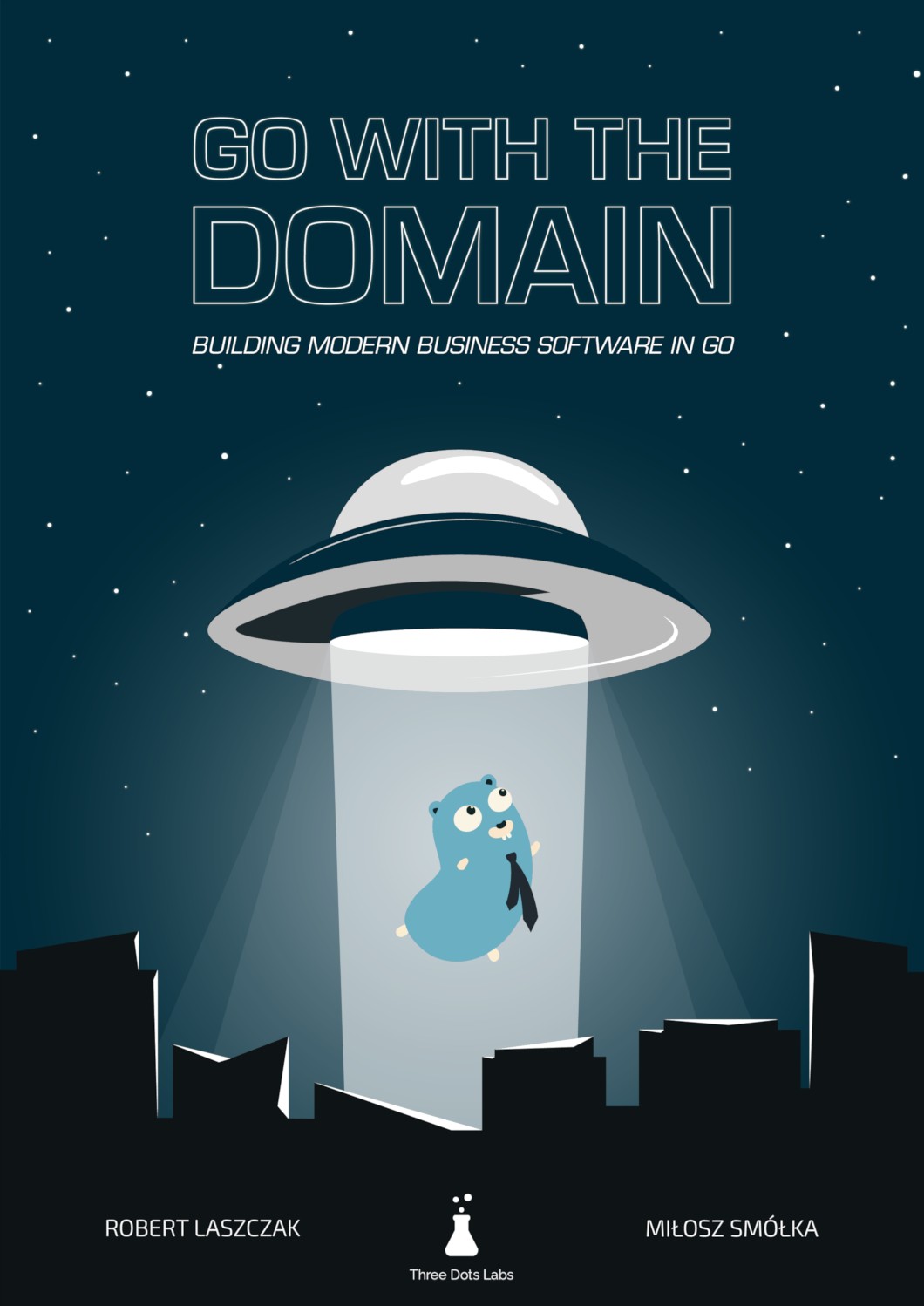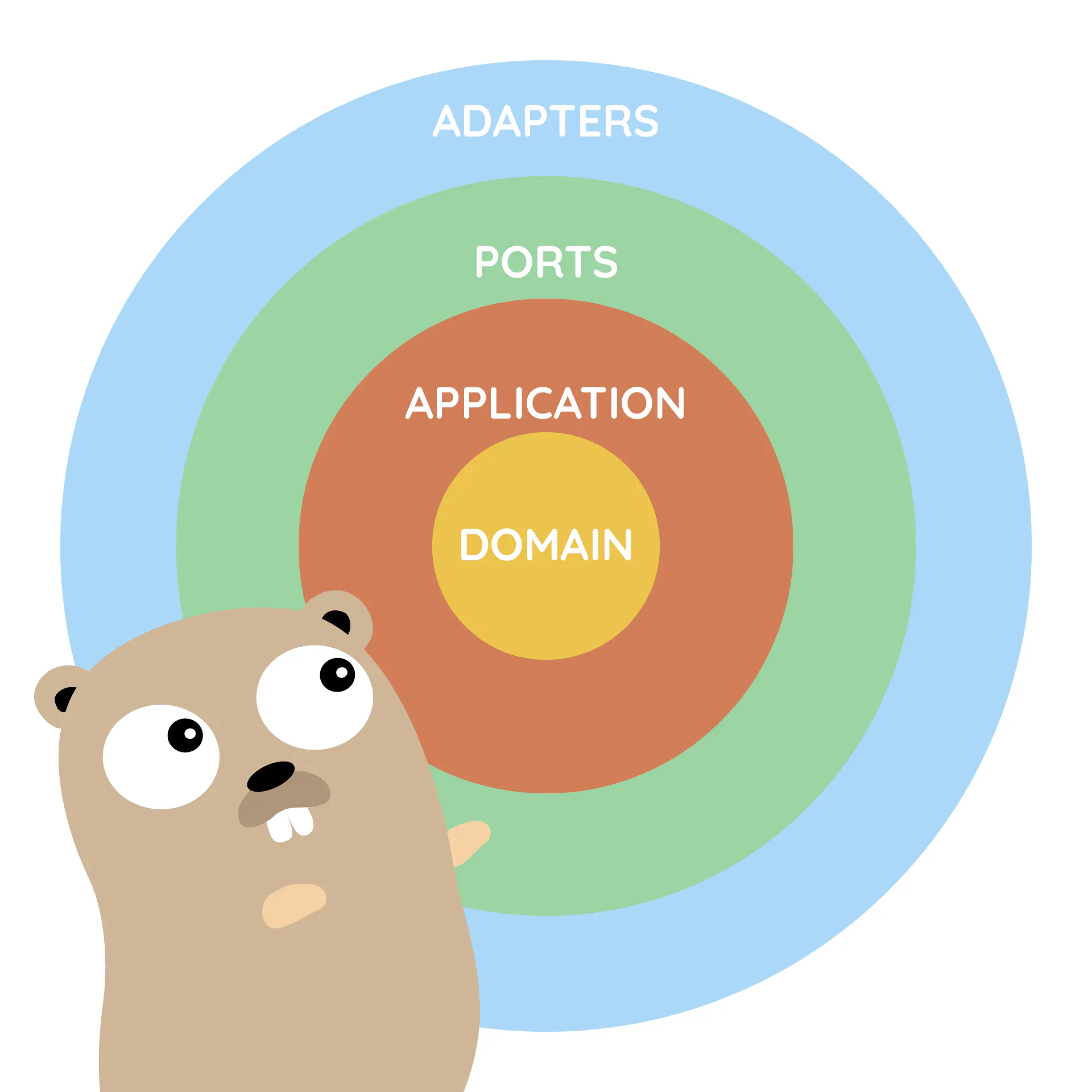How to use basic CQRS in Go
It’s highly likely you know at least one service that:
- has one big, unmaintainable model that is hard to understand and change,
- or where work in parallel on new features is limited,
- or can’t be scaled optimally.
But often, bad things come in threes. It’s not uncommon to see services with all these problems.
What is an idea that comes to mind first for solving these issues? Let’s split it into more microservices!
Unfortunately, without proper research and planning, the situation after blindly refactoring may be actually worse than before:
- business logic and flow may become even harder to understand – a complex logic is often easier to understand if it’s in one place,
- distributed transactions – things are sometimes together for a reason; a big transaction in one database is much faster and less complex than distributed transaction across multiple services,
- adding new changes may require extra coordination, if one of the services is owned by another team.
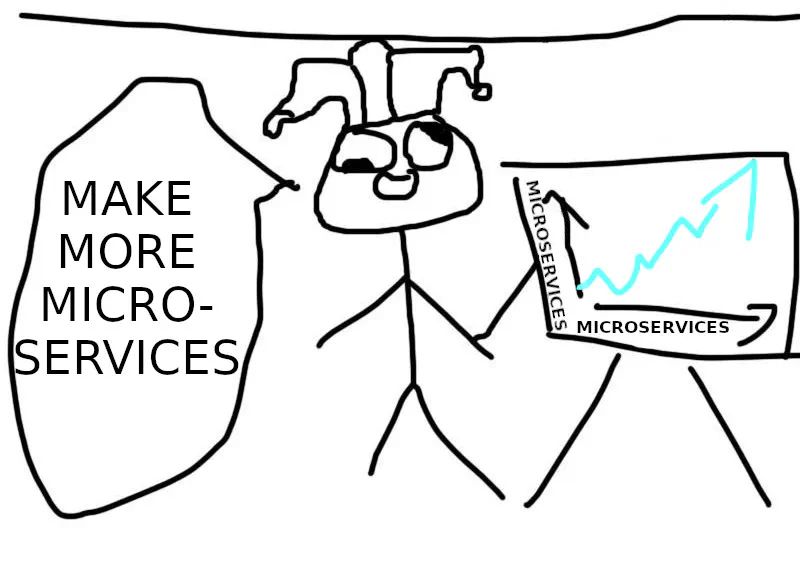
To be totally clear – I’m not an enemy of microservices. I’m just against blindly applying microservices in a way that introduces unneeded complexity and mess instead of making our lives easier.
Another approach is using CQRS (Command Query Responsibility Segregation) with previously described Clean Architecture and DDD Lite. It can solve the mentioned problems in a much simpler way.
Isn’t CQRS a complex technique?
Isn’t CQRS one of these C#/Java/über enterprise patterns that are hard to implement, and make a big mess in the code? A lot of books, presentations, and articles describe CQRS as a very complicated pattern. But it is not the case.
In practice, CQRS is a very simple pattern that doesn’t require a lot of investment. It can be easily extended with more complex techniques like event-driven architecture, event-sourcing, or polyglot persistence. But they’re not always needed. Even without applying any extra patterns, CQRS can offer better decoupling, and code structure that is easier to understand.
When to not use CQRS in Go? How to get all benefits from CQRS? You can learn all that in today’s article. 😉
Like always, I will do it by refactoring Wild Workouts application,
Note
This is not just another article with random code snippets.
This post is part of a bigger series where we show how to build Go applications that are easy to develop, maintain, and fun to work with in the long term. We are doing it by sharing proven techniques based on many experiments we did with teams we lead and scientific research.
You can learn these patterns by building with us a fully functional example Go web application – Wild Workouts.
We did one thing differently – we included some subtle issues to the initial Wild Workouts implementation. Have we lost our minds to do that? Not yet. 😉 These issues are common for many Go projects. In the long term, these small issues become critical and stop adding new features.
It’s one of the essential skills of a senior or lead developer; you always need to keep long-term implications in mind.
We will fix them by refactoring Wild Workouts. In that way, you will quickly understand the techniques we share.
Do you know that feeling after reading an article about some technique and trying implement it only to be blocked by some issues skipped in the guide? Cutting these details makes articles shorter and increases page views, but this is not our goal. Our goal is to create content that provides enough know-how to apply presented techniques. If you did not read previous articles from the series yet, we highly recommend doing that.
We believe that in some areas, there are no shortcuts. If you want to build complex applications in a fast and efficient way, you need to spend some time learning that. If it was simple, we wouldn’t have large amounts of scary legacy code.
Here’s the full list of 14 articles released so far.
The full source code of Wild Workouts is available on GitHub. Don’t forget to leave a star for our project! ⭐
How to implement basic CQRS in Go
CQRS (Command Query Responsibility Segregation) was initially described by Greg Young. It has one simple assumption: instead of having one big model for reads and writes, you should have two separate models. One for writes and one for reads. It also introduces concepts of command and query, and leads to splitting application services into two separate types: command and query handlers.
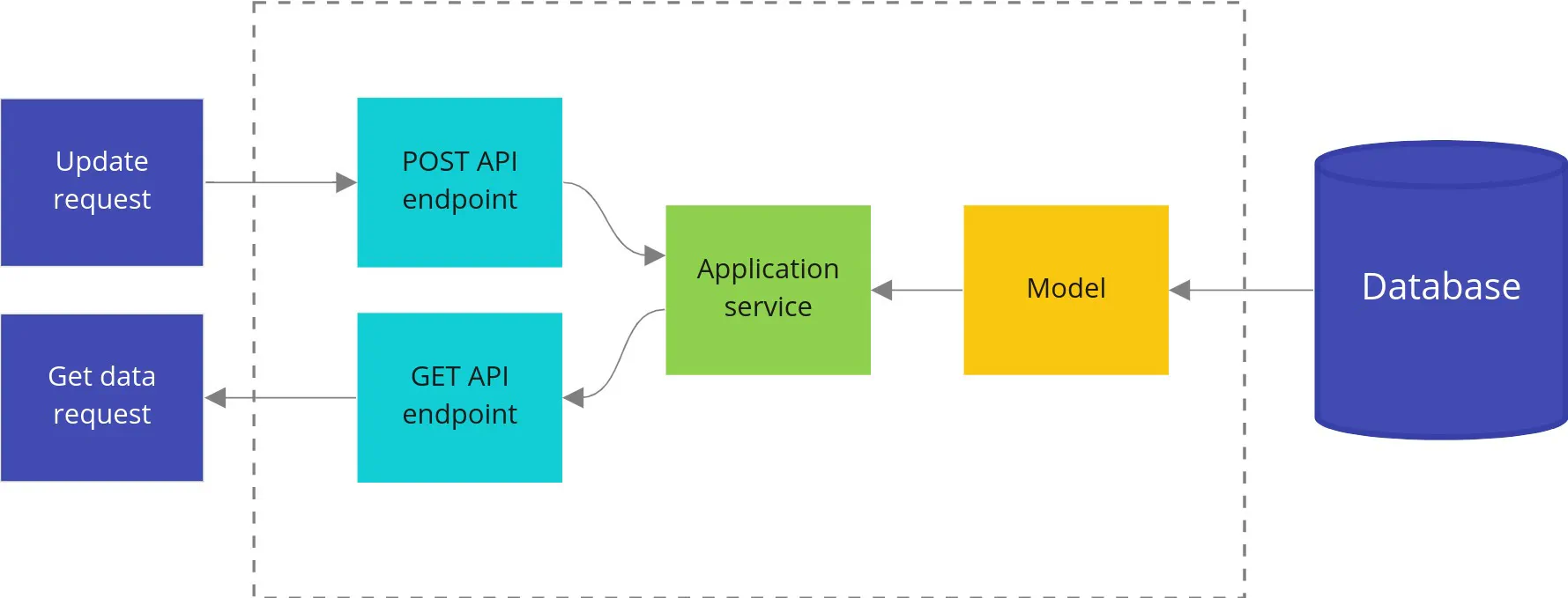

Command vs Query
In simplest words: a Query should not modify anything, just return the data. A command is the opposite one: it should make changes in the system, but not return any data. Thanks to that, our queries can be cached more efficiently, and we lower the complexity of commands.
It may sound like a serious constraint, but in practice, it is not. Most of the operations that we execute are reads or writes. Very rarely, both.
Of course, for a query, we don’t consider side effects like logs, or metrics as modifying anything. For commands, it is also a perfectly normal thing to return an error.
Note
As with most rules, it is ok to break them… as long as you perfectly understand why they were introduced and what tradeoffs you make. In practice, you rarely need to break these rules. I will share examples at the end of the article.
How does the most basic implementation look in practice? In the previous article, Miłosz introduced an application service that executes application use cases. Let’s start by cutting this service into separate command and query handlers.
ApproveTrainingReschedule command
Previously, the training reschedule was approved from the application service TrainingService.
- func (c TrainingService) ApproveTrainingReschedule(ctx context.Context, user auth.User, trainingUUID string) error {
- return c.repo.ApproveTrainingReschedule(ctx, trainingUUID, func(training Training) (Training, error) {
- if training.ProposedTime == nil {
- return Training{}, errors.New("training has no proposed time")
- }
- if training.MoveProposedBy == nil {
- return Training{}, errors.New("training has no MoveProposedBy")
- }
- if *training.MoveProposedBy == "trainer" && training.UserUUID != user.UUID {
- return Training{}, errors.Errorf("user '%s' cannot approve reschedule of user '%s'", user.UUID, training.UserUUID)
- }
- if *training.MoveProposedBy == user.Role {
- return Training{}, errors.New("reschedule cannot be accepted by requesting person")
- }
-
- training.Time = *training.ProposedTime
- training.ProposedTime = nil
-
- return training, nil
- })
- }
There were some magic validations there.
They are now done in the domain layer.
I also found out that we forgot to call the external trainer service to move the training. Oops. 😉
Let’s refactor it to the CQRS approach.
Note
Because CQRS works best with applications following Domain-Driven Design, during refactoring towards CQRS I refactored existing models to DDD Lite as well. DDD Lite is described in more detail in the previous article.
We start the implementation of a command with the command structure definition. That structure provides all data needed to execute this command. If a command has only one field, you can skip the structure and just pass it as a parameter.
It’s a good idea to use types defined by domain in the command, like training.User in that case.
We don’t need to do any casting later, and we have type safety assured.
It can save us a lot of issues with string parameters passed in wrong order.
package command
// ...
type ApproveTrainingReschedule struct {
TrainingUUID string
User training.User
}
The second part is a command handler that knows how to execute the command.
package command
// ...
type ApproveTrainingRescheduleHandler struct {
repo training.Repository
userService UserService
trainerService TrainerService
}
// ...
func (h ApproveTrainingRescheduleHandler) Handle(ctx context.Context, cmd ApproveTrainingReschedule) (err error) {
defer func() {
logs.LogCommandExecution("ApproveTrainingReschedule", cmd, err)
}()
return h.repo.UpdateTraining(
ctx,
cmd.TrainingUUID,
cmd.User,
func(ctx context.Context, tr *training.Training) (*training.Training, error) {
originalTrainingTime := tr.Time()
if err := tr.ApproveReschedule(cmd.User.Type()); err != nil {
return nil, err
}
err := h.trainerService.MoveTraining(ctx, tr.Time(), originalTrainingTime)
if err != nil {
return nil, err
}
return tr, nil
},
)
}
The flow is much easier to understand now.
You can clearly see that we approve a reschedule of a persisted *training.Training, and if it succeeds, we call the external trainer service.
Thanks to techniques described in the DDD Lite article, the command handler doesn’t need to know when it can perform this operation.
It’s all handled by our domain layer.
This clear flow is even more visible in more complex commands. Fortunately, the current implementation is really straightforward. That’s good. Our goal is not to create complicated, but simple software.
If CQRS is the standard way of building applications in your team, it also speeds up learning the service by your teammates who don’t know it. You just need a list of available commands and queries, and to quickly take a look at how their execution works. Jumping like crazy through random places in code is not needed.
This is how it looks like in one of my team’s most complex services:
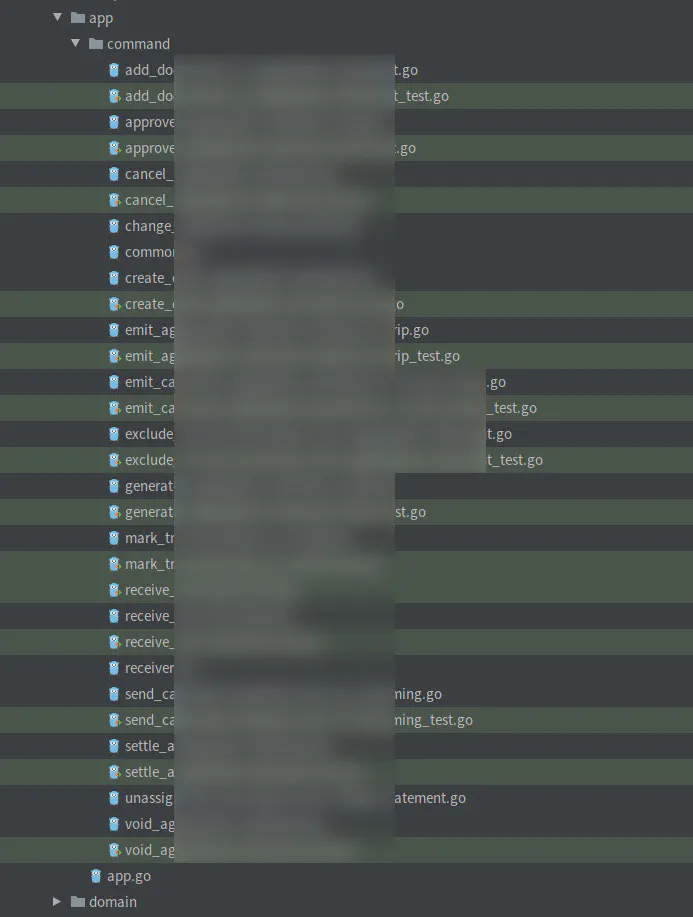
You may ask - shouldn’t it be cut to multiple services? In practice, it would be a terrible idea. A lot of operations here need to be transitionally consistent. Splitting it to separate services would involve a couple of distributed transactions (Sagas). It would make this flow much more complex, harder to maintain, and debug. It’s not the best deal.
It’s also worth mentioning that all of these operations are not very complex. Complexity is scaling horizontally excellently here. We will cover the extremely important topic of splitting microservices more in-depth soon. Did I already mention that we messed it up in Wild Workouts on purpose? 😉
But let’s go back to our command. It’s time to use it in our HTTP port.
It’s available in HttpServer via injected Application structure, which contains all of our commands and queries handlers.
package app
import (
"github.com/ThreeDotsLabs/wild-workouts-go-ddd-example/internal/trainings/app/command"
"github.com/ThreeDotsLabs/wild-workouts-go-ddd-example/internal/trainings/app/query"
)
type Application struct {
Commands Commands
Queries Queries
}
type Commands struct {
ApproveTrainingReschedule command.ApproveTrainingRescheduleHandler
CancelTraining command.CancelTrainingHandler
// ...
type HttpServer struct {
app app.Application
}
// ...
func (h HttpServer) ApproveRescheduleTraining(w http.ResponseWriter, r *http.Request) {
trainingUUID := chi.URLParam(r, "trainingUUID")
user, err := newDomainUserFromAuthUser(r.Context())
if err != nil {
httperr.RespondWithSlugError(err, w, r)
return
}
err = h.app.Commands.ApproveTrainingReschedule.Handle(r.Context(), command.ApproveTrainingReschedule{
User: user,
TrainingUUID: trainingUUID,
})
if err != nil {
httperr.RespondWithSlugError(err, w, r)
return
}
}
The command handler can be called in that way from any port: HTTP, gRPC, or CLI. It’s also useful for executing migrations and loading fixtures (we already do it in Wild Workouts).
RequestTrainingReschedule command
Some command handlers can be very simple.
func (h RequestTrainingRescheduleHandler) Handle(ctx context.Context, cmd RequestTrainingReschedule) (err error) {
defer func() {
logs.LogCommandExecution("RequestTrainingReschedule", cmd, err)
}()
return h.repo.UpdateTraining(
ctx,
cmd.TrainingUUID,
cmd.User,
func(ctx context.Context, tr *training.Training) (*training.Training, error) {
if err := tr.UpdateNotes(cmd.NewNotes); err != nil {
return nil, err
}
tr.ProposeReschedule(cmd.NewTime, cmd.User.Type())
return tr, nil
},
)
}
It may be tempting to skip this layer for such simple cases to save some boilerplate. It’s true, but you need to remember that writing code is always much cheaper than the maintenance. Adding this simple type is 3 minutes of work. People who will read and extend this code later will appreciate that effort.
AvailableHoursHandler query
Queries in the application layer are usually pretty boring.
In the most common case, we need to write a read model interface (AvailableHoursReadModel) that defines how we can query the data.
Commands and queries are also a great place for all cross-cutting concerns, like logging and instrumentation. Thanks to putting that here, we are sure that performance is measured in the same way whether it’s called from HTTP or gRPC port.
package query
// ...
type AvailableHoursHandler struct {
readModel AvailableHoursReadModel
}
type AvailableHoursReadModel interface {
AvailableHours(ctx context.Context, from time.Time, to time.Time) ([]Date, error)
}
// ...
type AvailableHours struct {
From time.Time
To time.Time
}
func (h AvailableHoursHandler) Handle(ctx context.Context, query AvailableHours) (d []Date, err error) {
start := time.Now()
defer func() {
logrus.
WithError(err).
WithField("duration", time.Since(start)).
Debug("AvailableHoursHandler executed")
}()
if query.From.After(query.To) {
return nil, errors.NewIncorrectInputError("date-from-after-date-to", "Date from after date to")
}
return h.readModel.AvailableHours(ctx, query.From, query.To)
}
We also need to define data types returned by the query. In our case, it’s query.Date.
Note
To understand why we don’t use structures generated from OpenAPI, you should check our articles on DRY and Clean Architecture.
package query
import (
"time"
)
type Date struct {
Date time.Time
HasFreeHours bool
Hours []Hour
}
type Hour struct {
Available bool
HasTrainingScheduled bool
Hour time.Time
}
Our query model is more complex than the domain hour.Hour type.
It’s a common scenario. Often, it’s driven by the UI of the website, and it’s more efficient to generate the most optimal responses on the backend side.
As the application grows, differences between domain and query models may become bigger. Thanks to the separation and decoupling, we can independently make changes in both of them. This is critical for keeping fast development in the long term.
package hour
type Hour struct {
hour time.Time
availability Availability
}
But from where AvailableHoursReadModel gets the data?
For the application layer, it is fully transparent and not relevant.
This allows us to add performance optimizations in the future, touching just one part of the application.
Note
If you are not familiar with the concept of _ports and adapters_, I highly recommend reading our article about Clean Architecture in Go.
In practice, the current implementation gets the data from our write models database.
You can find the AllTrainings read model implementation and tests for DatesFirestoreRepository in the adapters layer.

If you read about CQRS earlier, it is often recommended to use a separate database built from events for queries. It may be a good idea, but in very specific cases. I will describe it in the Future optimizations section. In our case, it’s sufficient to just get data from the write models database.
HourAvailabilityHandler query
We don’t need to add a read model interface for every query. It’s also fine to use the domain repository and pick the data that we need.
import (
"context"
"time"
"github.com/ThreeDotsLabs/wild-workouts-go-ddd-example/internal/trainer/domain/hour"
)
type HourAvailabilityHandler struct {
hourRepo hour.Repository
}
func (h HourAvailabilityHandler) Handle(ctx context.Context, time time.Time) (bool, error) {
hour, err := h.hourRepo.GetHour(ctx, time)
if err != nil {
return false, err
}
return hour.IsAvailable(), nil
}
Naming
Naming is one of the most challenging and most essential parts of software development. In Introduction to DDD Lite article I described a rule that says you should stick to the language that is as close as it can be to how non-technical people (often referred to as “business”) talk. It also applies to Commands and Queries names.
You should avoid names like “Create training” or “Delete training”. This is not how business and users understand your domain. You should instead use “Schedule training” and “Cancel training”.
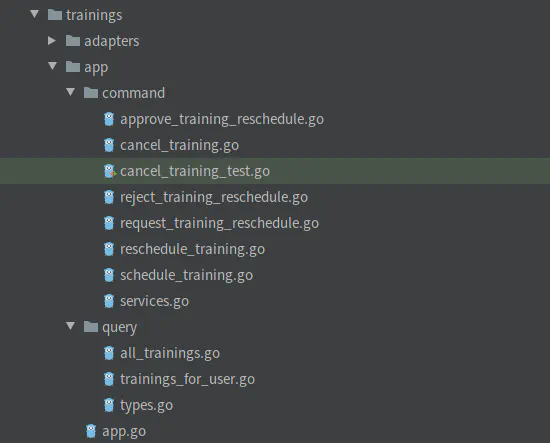
We will cover this topic deeper in an article about Ubiquitous Language. Until then, just go to your business people and listen how they call operations. Think twice if any of your command names really need to start with “Create/Delete/Update”.
Future optimizations
Basic CQRS gives some advantages like better code organisation, decoupling, and simplifying models. There is also one, even more important advantage. It is the ability to extend CQRS with more powerful and complex patterns.
Async commands
Some commands are slow by nature. They may be doing some external calls or some heavy computation. In that case, we can introduce Asynchronous Command Bus, which executes the command in the background.
Using asynchronous commands has some additional infrastructure requirements, like having a queue or a pub/sub. Fortunately, the Watermill library can help you handle this in Go. You can find more details in the Watermill CQRS documentation. (BTW We are the authors of Watermill as well 😉 Feel free to contact us if something’s not clear there!)
A separate database for queries
Our current implementation uses the same database for reads (queries) and writes (commands). If we would need to provide more complex queries or have really fast reads, we could use the polyglot persistence technique. The idea is to duplicate queried data in a more optimal format in another database. For example, we could use Elastic to index some data that can be searched and filtered more easily.
Data synchronization, in this case, can be done via events. One of the most important implications of this approach is eventual consistency. You should ask yourself if it’s an acceptable tradeoff in your system. If you are not sure, you can just start without polyglot persistence and migrate later. It’s good to defer key decisions like this one.
An example implementation is described in the Watermill CQRS documentation as well. Maybe with time, we will introduce it also in Wild Workouts, who knows?
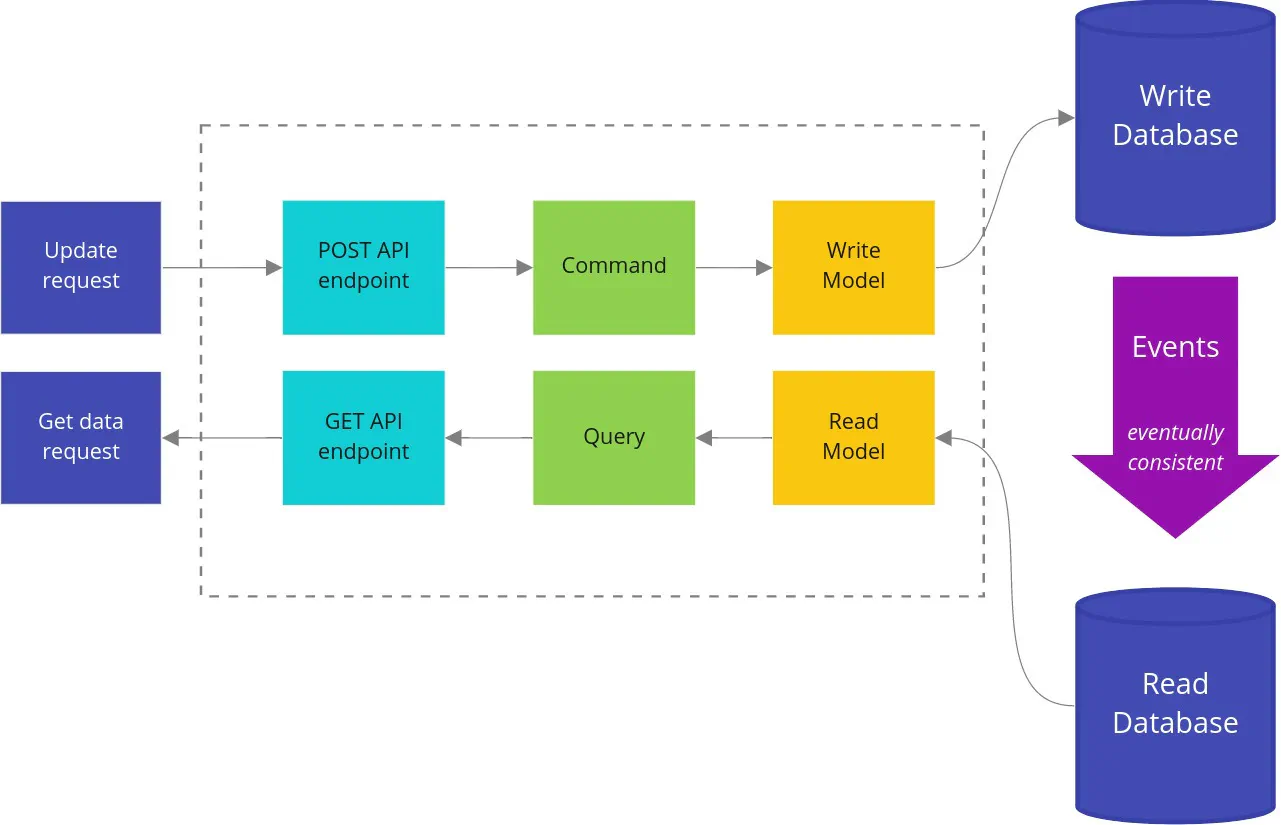
Event-Sourcing
If you work in a domain with strict audit requirements, you should definitely check out the event sourcing technique. For example, I’m currently working in the financial domain, and event sourcing is our default persistence choice. It provides out-of-the-box audit and helps with reverting some bug implications.
CQRS is often described together with event sourcing. The reason is that by design in event-sourced systems, we don’t store the model in a format ready for reads (queries), but just a list of events used by writes (commands). In other words, it’s harder to provide any API responses.
Thanks to the separation of command and query models, it’s not really a big problem. Our read models for queries live independently by design.
There are also a lot more advantages of event sourcing, that are visible in a financial systems. But let’s leave it for another article. 😉 Until then, you can check the Ebook from Greg Young – Versioning in an Event Sourced System. The same Greg Young who described CQRS.
When to not use CQRS?
CQRS is not a silver bullet that fits everywhere perfectly. A good example is authorization. You provide a login and a password, and in return, you get confirmation if you succeeded and maybe some token.
If your application is a simple CRUD that receives and returns the same data, it’s also not the best case for CQRS.
That’s the reason why users microservice in Wild Workouts doesn’t use Clean Architecture and CQRS.
In simple, data-oriented services, these patterns usually don’t make sense.
On the other hand, you should keep an eye on services like that.
If you notice the logic grows and development is painful, maybe it’s time for some refactoring?
Returning created entity via API with CQRS
I know that some people have a problem with using CQRS for the REST API that returns the created entity as the response of a POST request. Isn’t it against CQRS? Not really! You can solve it in two ways:
- Call the command in the HTTP port and after it succeeds, call the query to get the data to return,
- Instead of returning the created entity, return
204HTTP code with headercontent-locationset to the created resource URL.
The second approach is IMO better because it doesn’t require to always query for the created entity (even if the client doesn’t need this data). With the second approach, the client will only follow the link if it’s needed. It can also be cached with that call.
The only question is how to get created entity’s ID? A common practice is to provide the UUID of the entity to be created in the command.
This approach’s advantage is that it will still work as expected if the command handler is asynchronous. In case you don’t want to work with UUIDs, as a last resort you can return the ID from the handler – it won’t be the end of the world. 😉
cmd := command.ScheduleTraining{
TrainingUUID: uuid.New().String(),
UserUUID: user.UUID,
UserName: user.DisplayName,
TrainingTime: postTraining.Time,
Notes: postTraining.Notes,
}
err = h.app.Commands.ScheduleTraining.Handle(r.Context(), cmd)
if err != nil {
httperr.RespondWithSlugError(err, w, r)
return
}
w.Header().Set("content-location", "/trainings/" + cmd.TrainingUUID)
w.WriteHeader(http.StatusNoContent)
You can now put CQRS in your resume!
We did it – we have a basic CQRS implementation in Wild Workouts. You should also have an idea of how you can extend the application in the future.
While preparing the code for this article, I also refactored the trainer service towards DDD.
I will cover this in the next article.
Although the entire diff of that refactoring is already available on our GitHub repository.
Having every command handler as a separate type also helps with testing, as it’s easier to build dependencies for them. This part is covered by Miłosz in Microservices Test Architecture.
Are you using CQRS with any extensions? Do you have any project where you don’t know how to apply these patterns? Feel free to share and ask in the comments!